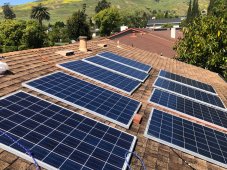sircambridge
New Member
- Joined
- Jul 9, 2022
- Messages
- 17
Hi everyone, I recently got dinged a 1000usd fine for what I believe to be a no-mount, off-grid system I put up a few weeks ago.
I bought 10x used 250 watt trina panels off facebook marketplace for 50 dollars each, and got a 5k growatt off-grid inverter and hooked it up to exclusively power my outdoor AC unit. I decided to be ambitious and throw them up on the roof, and planned to remove them before the rainy/windy season when it cools down. (I also added some spacers so theres a 1-inch gap above the roof, this is not in the photo attached)
maybe I was incredibly unlucky, but within 2 weeks the neighbor on my back side that is in view on the roof happened to have solar installers over on their roof, and I saw one of the guys take a picture. a few weeks later a "code enforcer" showed up and they fined me 1000 usd for an unpermitted solar install.
I happily removed the panels from the roof, restored everything and paid the fine, but I can now confirm the "no-mount, off-grid = no permit" is totally up to the inspector here in san jose, california. I dont plan to try and fight it, but the violation states that it was an "unpermitted solar install, installed on the roof, and hooked up to house electrical system".
I definitely dont want to fight the inspectors, since they are the ones that have the final say, but I do wonder if it was a correct interpretation of the code.
I bought 10x used 250 watt trina panels off facebook marketplace for 50 dollars each, and got a 5k growatt off-grid inverter and hooked it up to exclusively power my outdoor AC unit. I decided to be ambitious and throw them up on the roof, and planned to remove them before the rainy/windy season when it cools down. (I also added some spacers so theres a 1-inch gap above the roof, this is not in the photo attached)
maybe I was incredibly unlucky, but within 2 weeks the neighbor on my back side that is in view on the roof happened to have solar installers over on their roof, and I saw one of the guys take a picture. a few weeks later a "code enforcer" showed up and they fined me 1000 usd for an unpermitted solar install.
I happily removed the panels from the roof, restored everything and paid the fine, but I can now confirm the "no-mount, off-grid = no permit" is totally up to the inspector here in san jose, california. I dont plan to try and fight it, but the violation states that it was an "unpermitted solar install, installed on the roof, and hooked up to house electrical system".
I definitely dont want to fight the inspectors, since they are the ones that have the final say, but I do wonder if it was a correct interpretation of the code.




